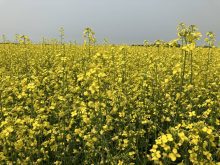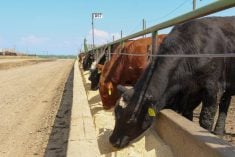During the first week of March, Alberta packers were buying fed cattle on a live basis at $273/cwt, down about $5/cwt from a month earlier.
The fed market has remained relatively firm due to lower supplies of market-ready cattle. Strength in the fed market has been supportive for the overall feeder complex.
Statistics Canada’s livestock inventory report as of Jan. 1 had feeder cattle supplies outside finishing feedlots in Western Canada slightly higher than 12 months earlier.
Read Also

Managing through market or individual stock declines
Even the best of public-traded companies can periodically experience significant drawdowns, and a successful investor should be prepared to react — or not react — accordingly, Herman VanGenderen writes.
Throughout January and February, many cow-calf operators were selling calves due to the U.S. tariff threat. Prices for feeders have climbed back to historical highs, which has also encouraged sales. Some backgrounders and finishers were moving cattle to custom lots south of the border.

Feeder cattle supplies are expected to tighten later in spring, which has spurred finishing operators to secure supplies.
During the last week of February, lower-flesh tan steers weighing 960 lbs. traded for $360 in central Alberta. Good-quality steers averaging 500-525 lbs. were actively trading in the range of $550-$575/cwt across the Prairies.
Cattle on feed in Alberta and Saskatchewan as of Feb. 1 were 1.013 million head, down two per cent or 21,205 head from Feb. 1, 2024. The on-feed number can be deceiving without looking closer at the data. Cattle on feed 120 days or longer as of Feb. 1 were only 187,917 head, down a whopping 96,515 head or 34 per cent from Feb. 1, 2024.
Market-ready fed cattle supplies are expected to remain relatively snug through mid-May before fall-placed calves start to come on the finished market. Steer carcass weights in Alberta are running 35 lbs. below year-ago levels, so feedlots are very current with production.
U.S. diverging
In the U.S., the opposite fundamental situation has developed. U.S. cattle on feed 150 days or longer as of February were 2.357 million head, down only 25,000 head from year-ago levels. The February slaughter will likely finish 150,000 head below last year, so we see a buildup of market-ready cattle during March. U.S. dressed weights are running over 40 lbs. above year-ago levels, which also confirms feedlots are backed up with market-ready supplies.
The U.S. continues to threaten tariffs on Canadian goods, with the situation very fluid at time of writing. The tighter fed cattle supply in Western Canada provides a cushion for fed cattle prices in the short term.
Apparently, U.S. beef is on the second wave of Canadian retaliatory tariffs. This will allow supply chains to manage the changes. There will be a surplus situation of beef in Canada during the summer, but we may see enhanced movement offshore, alleviating the supply situation.
The U.S. was initially part of the TPP (Trans-Pacific Partnership). In President Trump’s first term, he withdrew the U.S. from the TPP. However, that trade agreement’s agreed-upon beef volumes were not lowered when the U.S. withdrew. This is a partial win for Canada and Australia with additional access to countries such as Japan, Malaysia and Vietnam. These are smaller markets, but they can grow.
The feeder cattle market softened during the first week of February due to adverse weather and the earlier tariff threat.
However, by the end of the month, western Canadian feeder markets were back up near historical highs. Feeding margins are expected to remain in positive territory through the spring, which will continue to keep the feeder market at higher levels.
StatCan’s reported total yearlings (heifers for slaughter plus steers one year and older) on cow-calf operations and backgrounding operations as of Jan. 1, 2025 are at 587,300 head, up 1.4 per cent or 8,100 head from 12 months earlier.
Total calves in Western Canada under one year old outside finishing feedlots were 2.416 million head, up 31,600 head or 1.1 per cent from Jan. 1, 2024. This was a surprise to the trade. Now there has been a fair amount of sales and export movement over the past month. It’s hard to get a handle on the supply of feeder cattle that will come on the market during the spring period.
Heifers for beef cow replacement in Western Canada as of Jan. 1, 2025 were 465,900 head, up 1,500 head from last year. U.S. heifers for beef cow replacement as of Jan. 1, 2025 were only down about 46,000 head from 12 months earlier.
It appears the contraction phase in the cattle herd has stabilized and we’re expecting a sharper year-over-year increase in heifer retention during the summer and fall of 2025.
For the fall period, steers weighing 1,000 lbs. were trading in the range of $340-$350/cwt prior to March 4. After the U.S. tariffs were implemented on Canada, feedlots dropped their bids anywhere from $20-$50. There is a wait-and-see approach. Keep in mind, Canada is a net importer of feeder cattle, so this may have a minimal impact on the cow-calf producer.
When the market is at historical highs, producers have to assess risk/reward from a historical perspective. The market isn’t expected to fall apart but don’t expect significant upside from current levels.
If you are looking at buying grassers, the margins will be tight for these cattle because it’s hard to pencil out. For finishing feedlot operators, margins on incoming replacements barely cover the cost of the feeder animal and feed to finish. It’s hard to bank on further strength given the risks in the marketplace.
On a side note, the commitments of traders report from the U.S. Commodity Futures Trading Commission showed the commercial (packers) short position on live cattle futures was at an extreme earlier in February.
When this occurs, it’s a sign that packers have significant coverage in the cash market. We can say demand is full. Packers don’t need to be buying large volume of finished cattle at or near historical highs.
When this occurs, packers usually lower the price of wholesale beef to move product. This is exactly what has occurred through February as wholesale choice product has dropped nearly US$20/cwt. Packing margins are narrowing or being squeezed, which contributes to the lower U.S. slaughter pace.
















